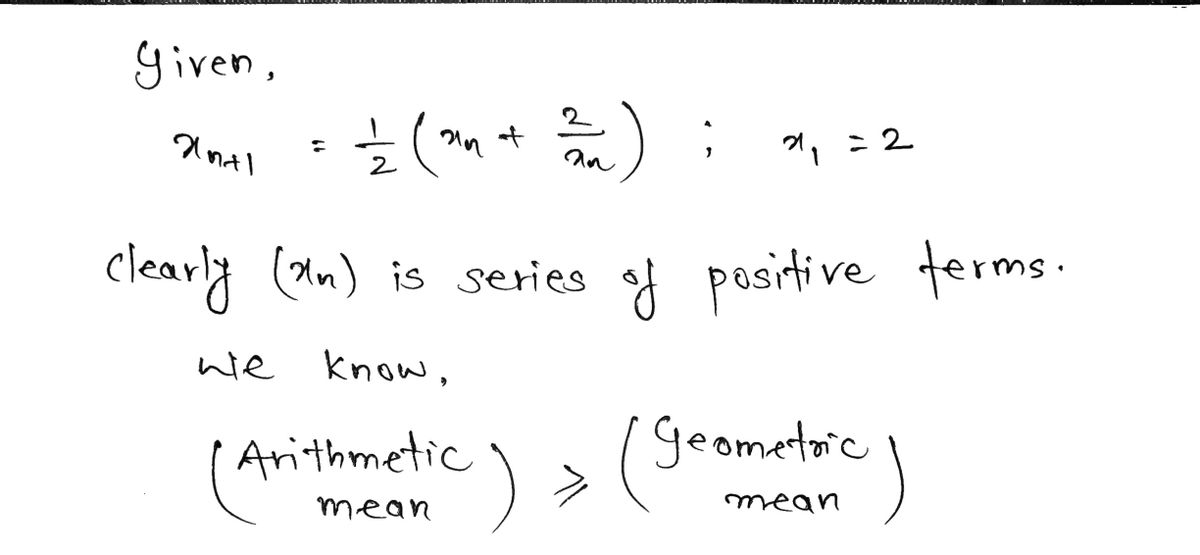
Advanced Engineering Mathematics
10th Edition
ISBN: 9780470458365
Author: Erwin Kreyszig
Publisher: Wiley, John & Sons, Incorporated
expand_more
expand_more
format_list_bulleted
Question
![follows: Let x₁
Define a sequence of real numbers (n) as
2, and supposing that an has been defined, define
=
to prove that In
lim = √2.
= 1/2 (² ₂ + 2²/1).
Xn
Xn
(a) Prove that x2 is always greater than or equal to 2, and then use this
n+10. [So (n) is decreasing.] Conclude that
-
Xn+1 =
(b) For any real number c > 0, define a sequence (yn) so that (yn)
converges to √c.](https://content.bartleby.com/qna-images/question/fa923b6f-81dd-482c-8885-6de6bc295751/0eaf1ae8-3161-4c6f-9cb5-c9368c8c3416/hiqpcd9_thumbnail.jpeg)
Transcribed Image Text:follows: Let x₁
Define a sequence of real numbers (n) as
2, and supposing that an has been defined, define
=
to prove that In
lim = √2.
= 1/2 (² ₂ + 2²/1).
Xn
Xn
(a) Prove that x2 is always greater than or equal to 2, and then use this
n+10. [So (n) is decreasing.] Conclude that
-
Xn+1 =
(b) For any real number c > 0, define a sequence (yn) so that (yn)
converges to √c.
Expert Solution
arrow_forward
Step 1

Step by stepSolved in 3 steps with 4 images

Knowledge Booster
Similar questions
- Prove that the function f : R → R is not continuous at xo = V2 f (x) = { if x E Q if x 4 Q x2 + 1 Explain why we can construct a sequence {xn}1 of rational numbers converging to v2. Have we proved this already?arrow_forwardLet n be a positive integer and let f : [0..n] → [0..n] be an injective function. Define the function g : [0..n] → Z as g(x) = n - (f(x))². Prove that is also injective.arrow_forwardA function f : Z → Z is defined by f(n) = 2n + 2. (a) Determine f(E), where E is the set of even integers. (b) Determine f-1(D), where D = {6k : k E Z}.arrow_forward
arrow_back_ios
arrow_forward_ios
Recommended textbooks for you
 Advanced Engineering MathematicsAdvanced MathISBN:9780470458365Author:Erwin KreyszigPublisher:Wiley, John & Sons, Incorporated
Advanced Engineering MathematicsAdvanced MathISBN:9780470458365Author:Erwin KreyszigPublisher:Wiley, John & Sons, Incorporated Numerical Methods for EngineersAdvanced MathISBN:9780073397924Author:Steven C. Chapra Dr., Raymond P. CanalePublisher:McGraw-Hill Education
Numerical Methods for EngineersAdvanced MathISBN:9780073397924Author:Steven C. Chapra Dr., Raymond P. CanalePublisher:McGraw-Hill Education Introductory Mathematics for Engineering Applicat...Advanced MathISBN:9781118141809Author:Nathan KlingbeilPublisher:WILEY
Introductory Mathematics for Engineering Applicat...Advanced MathISBN:9781118141809Author:Nathan KlingbeilPublisher:WILEY Mathematics For Machine TechnologyAdvanced MathISBN:9781337798310Author:Peterson, John.Publisher:Cengage Learning,
Mathematics For Machine TechnologyAdvanced MathISBN:9781337798310Author:Peterson, John.Publisher:Cengage Learning,


Advanced Engineering Mathematics
Advanced Math
ISBN:9780470458365
Author:Erwin Kreyszig
Publisher:Wiley, John & Sons, Incorporated

Numerical Methods for Engineers
Advanced Math
ISBN:9780073397924
Author:Steven C. Chapra Dr., Raymond P. Canale
Publisher:McGraw-Hill Education

Introductory Mathematics for Engineering Applicat...
Advanced Math
ISBN:9781118141809
Author:Nathan Klingbeil
Publisher:WILEY

Mathematics For Machine Technology
Advanced Math
ISBN:9781337798310
Author:Peterson, John.
Publisher:Cengage Learning,

